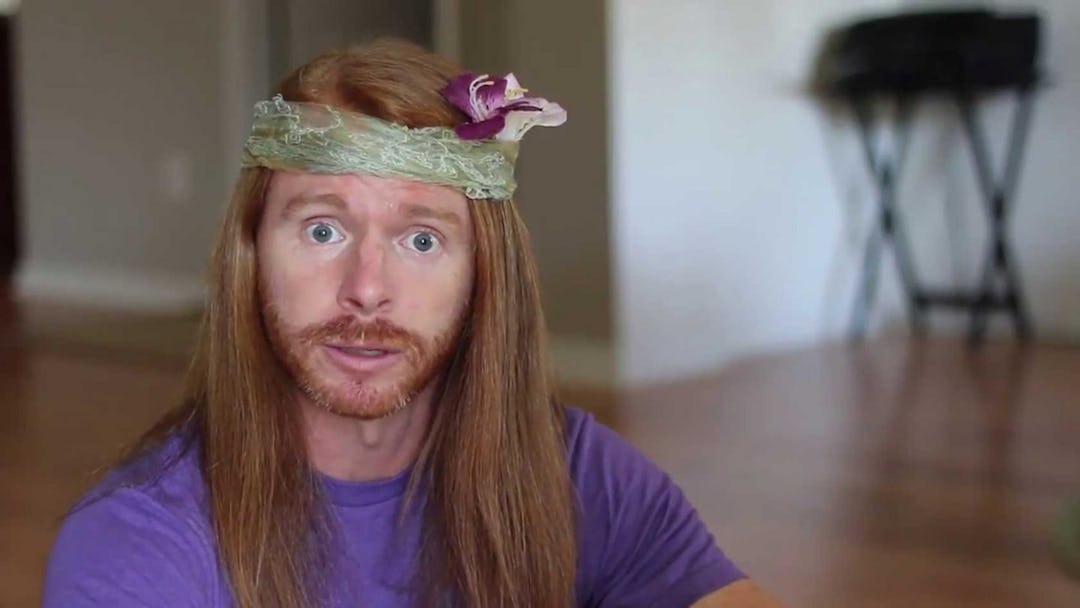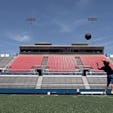It’s hard to take a guy who wears a lace headband and a purple orchid in his hair seriously, especially when he’s telling you how to become gluten intolerant and “ultra spiritual.” And if you’re confused whether JP Sears wants you to believe him or not, that’s just the way he likes it. The soft-spoken, ginger-headed, Youtube self-help guru is such a master of dry, deadpan comedy that it’s difficult to tell when he’s poking fun at the culture of life coaching versus when he really wants you to connect with your inner child—but, as he’ll tell you, there’s no reason he shouldn’t be able to do both at the same time.
Sears, a veteran “emotional healing coach” with a legit clinical background, is redefining what a granola, gluten-free, hippie can be, using humor to (in his words) “till the soil for a more sincere seed to be planted in [your] heart.” The 36 year-old star of such viral videos as “If Meat Eaters Acted Like Vegans” visited Onnit HQ recently to talk spirituality, healing, and just who the hell he really is.
Onnit: How did you get interested in spirituality?
Sears: In my late teens I began a search for something more. Something more than status and achievement. I just felt an emptiness inside, like there has to be more. I sure as heck didn’t know what I was searching for when I began but I think my mind started to become open.
This lack of meaning I felt inside got me to open my eyes to what else life might offer. From there I encountered some important mentors who opened me up to the spiritual world, which I would define as the world beyond the five senses.
Where do you think that emptiness came from? How were you raised?
I was raised pretend Catholic. My mother was Catholic and wanted my sister and I to be Catholic to please her parents because that’s how she was raised. But my dad was an atheist. So there was a nice balance. I got a taste of spirituality but not the kind of overwhelming dogma that can be traumatizing. I think the answer would be that I was very emotionally disconnected as a child and through my teenage years, and probably still to this day—although I’m working on it. I think the emotional disconnection really created a sense of emptiness—if I’m not connected to myself, of course I feel empty.
I would disconnect from emotions because I was trying to be the stable one in the family. I’m not allowed to be afraid or angry or sad because I need to be the one who brings balance and stability to the family. I need to take care of mom and dad. But what that really was was me not giving myself permission to be a child, and one of the important, beautiful gifts of being a child is being connected to your emotions.
Are you saying you never felt really happy or really sad?
I mean the peaks and valleys were really small. I’d feel a little happy at times, a little sad at times. But only feeling “a little.” Anything more than a little emotion one way or the other triggered the breaker that caused an electrical disconnect of my emotions. I didn’t know that was strange at the time because that’s just how things were.
“The worst life ever is a life that never changes. It may be the most comfortable life but it’s the least fulfilling.”
Who were these mentors who began to enlighten you?
Paul Chek [founder of the world famous C.H.E.K. Institute] was my first mentor. At first, I was interested in exercise and nutrition, so I sought out Paul. This was in 2001. At the time he wasn’t really open about his spiritual beliefs and teachings, so it was a surprise when I started learning spirituality from him—how people’s emotional health would heavily impact their physical health. My interest in him through exercise and nutrition was essentially the gluten-free breadcrumb trail that got me interested in the subtle aspects of life, like emotional health and spirituality. He was the messenger who could deliver it to me. I saw Paul at the time as a rock star.
If some boring-looking dude in a suit had shown up and started talking about emotions, I would have said “Whatever. I don’t want to hear about it.” But when it’s Paul Chek, I thought, “Yes, I DO want to hear about it,” because I found him very interesting.
The next mentor I had was John McMullin [journeysofwisdom.com], and he’s more directly all about emotional healing. He’s an amazing person—an angel inside of a human body. I learned how to work with people at the heart level. How to resolve pain, wounding, trauma, self-sabotage, and self-imposed limitations. The most integral part of my journey, of course, has been working on myself.
You’ve said that you discovered your own need for emotional healing by coaching others. Have you been able to heal your own wounds?
Have I healed them? Probably not. Am I healing? Hopefully. I think healing is probably infinite. After we get out of acute pain we might start calling it growth but it’s the same thing. I’m still affected by my wounding but I’ve made progress on it. The first real meaningful wound that I became aware of was on December 3, 2002.
Wow, you remember the exact date?
I was 21. I had been working with Paul Chek so my mind was open but my heart hadn’t quite arrived yet. It arrived on December 3. It was the afternoon of my first class with John McMullin. He’s very intuitive and he saw through the stoic façade I had—the “I have everything put together in my life.” This was such a persistent façade that I thought it was real. I thought this is how I am. I am so strong, stable, and put together. I hadn’t cried for at least six years before that day, probably longer.
John brought up a time when I was seven and my parents were going through a separation and my sister was relying on me as a father figure. John brought up questions that made me look at that and realize how tough that was for me and I really hated it but I started to connect to emotions. I started bawling my eyes out and that was so unnerving for me because who I thought I was was suddenly shattered. It’s not what I wanted but it really was what I needed. I opened my heart to emotions, unresolved pain. It initiated an ongoing journey to connect emotionally to who I really am.
So what exactly is your job? Are you a coach, a counselor?
Present day, I don’t know how to define it. I’m a collage of different things: Youtuber, speaker, performer, author. I coach people at retreats and make guest appearances. I’ve always worked in the “helping people” profession under the umbrella of a coach. So how I became a coach is that I started working with people as a personal trainer, doing exercise and nutrition. Then as I was getting more into the emotional coaching world and getting really passionate about that, I started applying that work to my existing exercise clients. It was a smooth transition.
I was put through a steel mace workout today by @erikmelland. I used all of 10 pounds and it was still too much. I benefited immensely and didn’t enjoy any of it ? Go CNS or go home! #ONNIT #SteelMace #LookAtMyLeftBicep
What is different about the kind of coaching you’ve done versus what people would get from a traditional therapist?
With a traditional therapist, someone might have a condition that needs treatment and the therapist might be treating symptoms. That’s not what I do. I focus on facilitating the person getting connected to their inner wisdom and their own emotions, whether they’re emotions that are being generated now or leftover from 50 years ago. I don’t tell people what to do; I help them find their own answers.
What’s the advantage for someone in seeing a coach like you, versus a psychologist or social worker?
That’s a good question. Being challenged, I think. When a person is in a place where being challenged is helpful to them, there’s an advantage to my system. But when a person needs outside support, or is in a really compromised situation, then I wouldn’t be at all convinced that how I do things is best.
But when a person is in a place where they’re stuck, they’re somehow not progressing in life or toward a deeper inner peace, they have reoccurring patterns of dysfunction, then how I coach them is challenging them to connect more deeply to themselves, to take new risks, to encounter discomfort inside of themselves that they’ve maybe been avoiding. To me, a good coach is someone who appropriately guides someone into discomfort that is for their greater good, kind of like a personal trainer. Much like a trainer, the coach isn’t doing the workout for the person, they’re standing in a role of support and offering guidance.
“I think if there’s an undercurrent to all my videos it’s a message that transparency and authenticity wins, rather than covering up who we are.”
Can you give an example of how you challenge people?
A very common example is when people show up and they’re depressed or dealing with pain. I’ll ask, “How are you benefitting from this pain and depression?” Of course, it’s easy for them to say, “I’m not. I hate it.” Yes, part of you hates it, and how does part of you potentially love it so much and find so much comfort through the recurring discomfort of it that you won’t let it heal? How might that be possible?
I challenge them to find the more deeply-rooted pain. I help them create awareness and ask specific questions. A lot of time it goes back to childhood. That’s what causes our blockages. So I help them reframe childhood experiences.
Could you give us a guide to start self-healing?
There’s what I call the FFF meditation exercise: it stands for “Feel your Fucking Feelings.” It’s so simple yet it’s very beneficial. Sit there and pick one body sensation you have right now. Maybe it’s tingling in your chest or aching in your thigh, tightness here or there. Just pick one and focus on it and bring your attention to it and breathe with it for five minutes. You’re not trying to make it any different or make it go away or make it good or bad. Just pay attention to it and breathe with it.
This trains your emotional muscles. We go through life and we have years of education for our intellectual mind but zero hours of education for our emotional mind. So a lot of us have very weak emotional muscles. Like actual muscles, when we use them they get stronger. Exercising our ability to feel anything strengthens our connection to our emotions. Emotional muscles are typically kind of weak.
Understand that this exercise is not about accomplishing anything. That’s what our intellectual pursuits are about but that’s not how emotions work. Emotions work emotionally, so we cant apply a logical mindset to them.
One of your former clients works here. He says you helped him realize he had to break up with his girlfriend, and that by doing so, his back pain went away.
I think he’s giving me too much credit, but with that said, I think the fear he had of leaving the relationship— the sense that he’d be letting her down if he leaves her—whatever the emotion was he was avoiding by carrying on the relationship was weighing him down. I think it’s amazing how the body is a biofeedback instrument that’s always showing us what’s going on in the intangible reality of our psyche. His psyche was burdened. He wanted to spread his wings but he wasn’t letting that happen. The body mirrored what was going on in his psyche. The question we have to ask ourselves is, “Am I wise enough to become curious about what pain in my body is trying to teach me?” And then pain becomes our friend.
It’s hard to know where the JP Sears character ends and the real man begins. Can you summarize your own philosophy—from the real JP Sears—on how people should live?
It’s a good question. People should probably definitely not live the way that I think they should live [laughs]. They should live based on their calling. As a generalization, I think meaning and a sense of purpose in life comes when we’re willing to explore mystery. He or she who’s willing to step deeper into mystery will always find more meaning relative to if they stay in their comfort zone. Become a curious student of life who’s willing to move toward discomfort and challenge him or herself rather than avoid discomfort. This challenge is hopefully physical and mental.
Some big-time athletes get addicted to challenging themselves only physically. They’ll do amazing things but that might be a defense mechanism to avoid things psychologically. Then there are people who are really tapped into their heart and they completely bypass the fact that they’re in a human body too that deserves to be challenged. When we grow we realize more of the magnitude of what we already are and always have been. Our awareness expands when we’re willing to embrace discomfort.
“Authenticity is when we look at our gifts and look at our flaws and we say yes to both”
Some athletes probably have the fear that if they look within themselves and confront some of the issues that make them work so hard physically, they might lose their edge and wont be as good of a competitor.
That could happen, and it probably does some of the time. Another possibility is that your “why” will change. If someone is an MMA competitor and say they were picked on as a kid and overlooked by their parents, they may feel this sense of insignificance. They created this compensation mechanism that is the desire to get into MMA and fight to prove how significant they are—“I’m going to dominate you and make you the insignificant one so I can feel significant.” But then they find that they only feel that way for 10 minutes after the fight.
An athlete’s whole why behind athletic endeavors could be to escape himself. So maybe if he connects with himself his why will change. Maybe his new why allows him to show up even more for his athletic endeavors because it’s more aligned with his heart—rather than a fear-based why that’s about escaping emotions.
On the other hand, maybe the fighter realizes he wanted to fight to feel more significant, but he’s over that now and doesn’t want to train anymore at all. He’s not a fighter anymore. Maybe that is the case, but he’s happier, and he finds something else that’s more meaningful to him. That’s a big win. The worst life ever is a life that never changes. It may be the most comfortable life but it’s the least fulfilling.
You’ve said you started doing funny videos because you needed to. What did you mean by that?
I was being tickled by the creative muse. And I may sound like the ultimate cliché, ultra-spiritual artist, but that’s OK. Expressing deeper perspectives through the language of comedy was an expression that wanted to come through me, and I was resisting it. After a while I was like, “I’ve got to allow this to happen.” So for the first 13 years of my career, I didn’t allow my sense of humor to come out publicly. That was me betraying myself. That was me looking at my inner comedian and saying, “You’re not good the way you are. You will be bad for business. You’re flawed the way you are so I can’t let you be seen.”
It was self-inflicted shame and self-betrayal. I couldn’t do that anymore. I had to put my arm around this creative part of me and say you’re welcome in my life. This creative part of me has brought so much more value to my life. On the inside it feels so much more fulfilling to be embracing this part of me and I’ve come to learn that the comedic part is good for business and it allows me to connect with a lot of people.
How can we tell the serious videos apart from the humor ones? Are you always wearing a flower in your hair when you do jokes?
If there’s a flower in my hair it’s definitely a comedy video. But the past six months I haven’t been making videos with the flower. For the past year I’ve just been putting out comedy videos. I think the only real way to tell what the intent is is to watch it. When I do comedy, at the same time, it’s not just comedy because there is a deeper consideration that I’d like people to contemplate. It’s important to me not to put myself in a box and only communicate through comedy. It just so happens that on video at the present time the only videos I’m doing are comedy. But when I do live speaking I do stand-up comedy and then what I call stand-up authenticity where I’m speaking from my heart. Comedy is a language that gets people’s attention and once the attention is there, I can get into their hearts. With live events I do a lot of sincere talking. In the not too distant future I’ll have some various projects that have comedy but are largely sincere. And I’ll do more sincere videos in the future, but right now I’ve got them on a temporary hiatus.
Do you enjoy confusing your audience? It seems that even some of your biggest fans can’t always tell what your message is and when you’re being facetious.
I do enjoy confusing people. I think confusion is sometimes an uncomfortable place to be but a beneficial place to be. Because it means we have to connect deeper to our inner resources. So if someone is confused about me—is he serious or is he comedic—they can’t put me into a box so they don’t have to think. What if I’m both?
People are used to conforming to something. Even if you say, “I don’t conform to anything,” well, that’s a box too. We all deserve to look at what box we put ourselves in and challenge ourselves to be bigger than a box. It won’t be so easy for people to comprehend us in a few seconds and that’s OK.
It seems like happiness and peace of mind for you is largely about lightening up. Many of your humor videos take the piss out of things you actually believe in very strongly, but it seems like you’re saying that if people could see both sides of it—be spiritual but you don’t have to be spiritual all the time—they would be OK.
For me the message goes beyond the spiritual genre because life is bigger than that. When we have certain beliefs we begin to think we are these things we believe in. But I believe that being the miraculous human beings we are is something much bigger. I believe my videos are shining the light on rigid beliefs, ways we hide from ourselves, how we try to cover up some of our chaotic human nature, our pretentiousness and self-righteousness. I think if there’s an undercurrent to all my videos it’s a message that transparency and authenticity wins, rather than covering up who we are. Have your beliefs but don’t believe them like they’re the gospel.
One of the most egotistical things a person can do is try to be ego-less. If someone says, “material things don’t mean anything to me because I’m above all that,” I think, “how egotistical.” When we get into trouble is when we actually care but we pretend that we don’t. It’s not authentic. Authenticity is when we look at our gifts and look at our flaws and we say yes to both. Our flaws are also our gifts. We just don’t see how they’re amazing yet.
What’s next for you?
Theres a TV show being shopped around to networks that may get picked up. Cool if it is; certainly OK if it isn’t. It would be kind of a sketch comedy show. We’ll see what happens. There will be more books in the future. Later this year I’ll do more of a full-on stand-up comedy, authenticity tour.
Visit Sears at awakenwithJP.com


)






